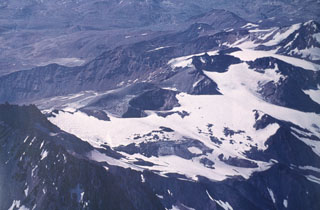Report on Planchon-Peteroa (Chile) — 31 May-6 June 2017
Smithsonian Institution / US Geological Survey
Weekly Volcanic Activity Report, 31 May-6 June 2017
Managing Editor: Sally Sennert.
Please cite this report as:
Global Volcanism Program, 2017. Report on Planchon-Peteroa (Chile) (Sennert, S, ed.). Weekly Volcanic Activity Report, 31 May-6 June 2017. Smithsonian Institution and US Geological Survey.
Planchon-Peteroa
Chile
35.223°S, 70.568°W; summit elev. 3977 m
All times are local (unless otherwise noted)
Based on Observatorio Volcanológico de los Andes del Sur (OVDAS) - SERNAGEOMIN observations, ONEMI reported on 17 May that the number and magnitude of earthqaukes at Planchón-Peteroa had gradually declined during the past months, reaching baseline levels. Minor to no surface activity was noted. OVDAS-SERNAGEOMIN lowered the Alert Level to Green (the lowest level on a three-color scale), and ONEMI canceled the Yellow Alert for the communities of Molina (66 WNW), Curicó (68 km NW), Romeral (75 km NW), and Teno (68 km NW) that had been in place since 1 July 2016.
Geological Summary. Planchón-Peteroa is an elongated complex volcano along the Chile-Argentina border with several overlapping calderas. Activity began in the Pleistocene with construction of the basaltic andesite to dacitic Volcán Azufre, followed by formation of the basaltic and basaltic andesite Volcán Planchón, 6 km N. About 11,500 years ago much of Azufre and part of Planchón collapsed, forming the massive Río Teno debris avalanche, which traveled 95 km to reach Chile's Central Valley. Subsequently, Volcán Planchón II was formed. The youngest volcano, andesitic and basaltic andesite Volcán Peteroa, consists of scattered vents between Azufre and Planchón, and and contains a small steaming crater lake. Reported eruptions from the complex have been dominantly explosive, although lava flows were emplaced in 1837 and 1937.
Source: Oficina Nacional de Emergencia-Ministerio del Interior (ONEMI)

